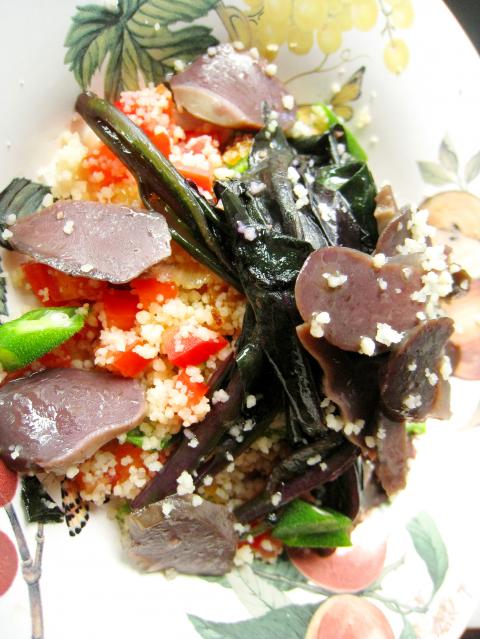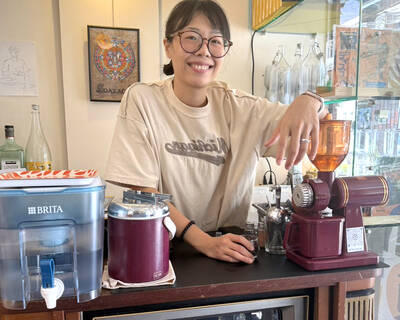Gynura Bicolor (紅鳳菜) is one of many vegetables that sports impressive nutritional and environmental credentials but has resolutely failed to be embraced by the mainstream. This is perhaps not surprising, as its fleshy leaves can easily become slimy.
Gynura bicolor is also called Okinawan spinach, but it is not in fact related to regular spinach in any way. Gynura bicolor is actually a member of the chrysanthemum family, with hints of bitterness that has many regarding it purely as a medicinal herb unsuitable for the dinner table.
While gynura bicolor looks quite attractive in its raw state, with leaves that are a dark olive green on one side and a vibrant purple of the other, contact with moisture will very quickly turn the leaves into a muddy slime. When cooked, the leaves also turn an unattractive drab khaki, with the purple bleeding into any liquid on the plate, forming a bloody soup that is remarkably unappetizing.

Photo: Ian Bartholomew
It is the case that gynura bicolor can be eaten raw, preserving its attractive colors, but its taste and texture in this state, while not entirely unappealing, does take some getting used to.
With so many negatives you may wonder why anyone would want to cook with such a vegetable, but that’s not to reckon with the vegetables significant advantages. First and foremost, gynura bicolor is a perennial and so available throughout the year, but it is currently at its best. It flourishes during autumn and early winter, and when other vegetables are being ravaged by the pests of the rainy season, gynura’s astringent flavors keep it safe without the need for the copious amounts of pesticide that are used to protect more delicate leaves.
Gynura bicolor is often regarded as a medicinal herb and so unsurprisingly Chinese pharmacology has much to say about it, recommending it for promoting blood circulation and detoxification. It is said to be good at alleviating anything from pimples to tumors, and a poultice of gynura bicolor is also helpful in treating cuts and other external injuries. As a powerful anti-inflammatory, the Formosa Cancer Foundation has nothing but praise for this vegetable. It is also rich in iron and potassium, calcium and Vitamin A.

Photo: Ian Bartholomew
Chinese medical lore groups gynura bicolor as a “cold” food, and in traditional Chinese cuisine it is usually prepared with “warming” ingredients such as ginger, sesame oil or rice wine. Whatever the medical justification for this, it certainly makes for a solid flavor combination and, at its most basic, gynura bicolor can be made into a quick stir fry with a splash of dark sesame oil heated with minced ginger. For a richer flavor, the addition of Shaoxing wine (紹興酒) or even sherry works remarkably well.
With all the rain Taiwan has been getting over the last month or so, it is a sobering sight to see the fields near my house in Hualien being mercilessly sprayed with pesticide to keep the crops safe from the swarming hordes of snails and other pests. Sticking to hardy tropical vegetables that are adapted to our hot, wet weather seems like a good idea at times like these.
Gynura Bicolor with Confit Duck Gizzards and Couscous
Recipe
(serves four)
This dish of gynura bicolor has been coupled with duck gizzard as a celebration of earthy flavors and unconventional textures. Confit duck gizzard is also something that is well suited to making in bulk and putting by for when you want to inject a burst of flavor into your meal. It keeps well for weeks in the fridge and can be minced or sliced to pair with all kinds of vegetables. My own favorite is a combination with fried cabbage, which soaks up the strong flavors. Investing in a quality bottle of dark sesame oil is also a must as it provides the important base notes for this vegetable.
Ingredients
1 small bunch gynura bicolor
1 small nub ginger, minced
1 tsp dark sesame oil
4 tsp olive oil
1 tbsp Shaoxing wine
Salt
50g couscous
80ml vegetable stock
1 firm tomato, seeds removed, diced
6 okra, steamed, diced
1 onion, finely sliced
2 confit duck gizzards (recipe follows)
Directions
For the couscous
1. Bring the vegetable stock to a boil, add couscous and cover. Remove from heat and allow to sit for about five minutes.
2. Separate the grains of couscous with a fork and season lightly with salt.
3. In a heavy skillet, heat the olive oil over medium heat and add the onions and fry until they are soft and acquire a rich caramel color and fragrance.
4. Mix in couscous, then add tomato and okra.
For the vegetable
1. The stems of the gynura bicolor can be woody, so remove if necessary and discard any leaves that are bruised or turning black. Wash gently.
2. Heat a mix of 2 teaspoons olive oil and the sesame oil in a heavy saute pan. Add the ginger and cook over low heat until fragrant.
3. Add the gynura bicolor leaves and stir, coating the leaves with the oil and allow to soften slightly. Season with salt and add the wine. Cook for about a minute.
To finish
Finely slice the confit duck gizzard and add it to the couscous mix. Top with the vegetables.
Confit duck gizzard
Ingredients
1kg duck gizzards
1kg duck fat (or lard at a pinch)
30g salt
6g pepper
1 bay leaf
Directions
1. Mix the salt, bay leaf and pepper in a grinder.
2. Slice the garlic finely.
3. Wash and dry the gizzards, toss in the salt mixture and refrigerate for 24 hours.
4. Wash off the salt and pat the gizzards dry. Cover with duck oil.
5. Preheat oven to 100c.
6. Heat the gizzards and oil on the stove until the first bubbles begin to appear. Transfer to the preheated oven to cook for three hours.
7. Allow to cool. Store the gizzards covered in the duck oil, digging one out when you need it, making sure the remaining gizzards remain sealed in the fat. Keeps well for up to a month.
Ian Bartholomew runs Ian’s Table, a small guesthouse in Hualien. He has lived in Taiwan for many years writing about the food scene and has decided that until you look at farming, you know nothing about the food you eat. He can be contacted at Hualien202@gmail.com.

Cheng Ching-hsiang (鄭青祥) turned a small triangle of concrete jammed between two old shops into a cool little bar called 9dimension. In front of the shop, a steampunk-like structure was welded by himself to serve as a booth where he prepares cocktails. “Yancheng used to be just old people,” he says, “but now young people are coming and creating the New Yancheng.” Around the corner, Yu Hsiu-jao (饒毓琇), opened Tiny Cafe. True to its name, it is the size of a cupboard and serves cold-brewed coffee. “Small shops are so special and have personality,” she says, “people come to Yancheng to find such treasures.” She

Late last month Philippines Foreign Affairs Secretary Theresa Lazaro told the Philippine Senate that the nation has sufficient funds to evacuate the nearly 170,000 Filipino residents in Taiwan, 84 percent of whom are migrant workers, in the event of war. Agencies have been exploring evacuation scenarios since early this year, she said. She also observed that since the Philippines has only limited ships, the government is consulting security agencies for alternatives. Filipinos are a distant third in overall migrant worker population. Indonesia has over 248,000 workers, followed by roughly 240,000 Vietnamese. It should be noted that there are another 170,000

In July of 1995, a group of local DJs began posting an event flyer around Taipei. It was cheaply photocopied and nearly all in English, with a hand-drawn map on the back and, on the front, a big red hand print alongside one prominent line of text, “Finally… THE PARTY.” The map led to a remote floodplain in Taipei County (now New Taipei City) just across the Tamsui River from Taipei. The organizers got permission from no one. They just drove up in a blue Taiwanese pickup truck, set up a generator, two speakers, two turntables and a mixer. They

Hannah Liao (廖宸萱) recalls the harassment she experienced on dating apps, an experience that left her frightened and disgusted. “I’ve tried some voice-based dating apps,” the 30-year-old says. “Right away, some guys would say things like, ‘Wanna talk dirty?’ or ‘Wanna suck my d**k?’” she says. Liao’s story is not unique. Ministry of Health and Welfare statistics show a more than 50 percent rise in sexual assault cases related to online encounters over the past five years. In 2023 alone, women comprised 7,698 of the 9,413 reported victims. Faced with a dating landscape that can feel more predatory than promising, many in